AMC 8 Daily Practice Round 7
Complete problem set with solutions and individual problem pages
The following figure is a side view of a staircase. It is known that each step is wide and high. What is the perimeter of the side of this staircase in meters?
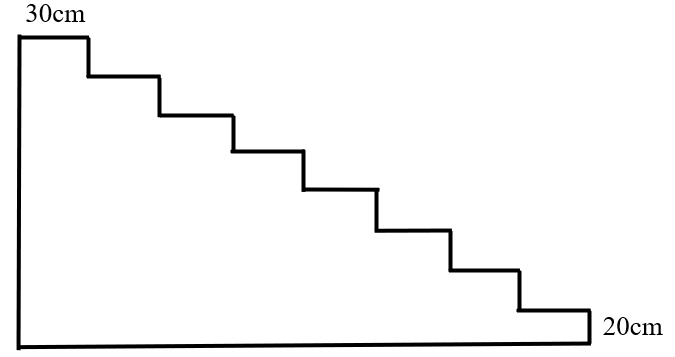
- A.
- B.
- C.
- D.
- E.
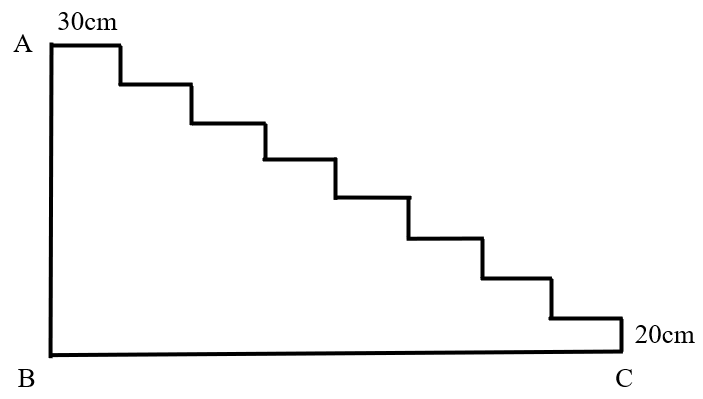
Through translation, it can be known that the length of the staircase in the figure is , and the height of the staircase is .
Therefore, the perimeter of the side of the staircase is .
Note the unit conversion: .
Thus, the final answer is .
A large rectangle is divided into four pieces. Given that the perimeter of piece is , the perimeter of piece is , and the perimeter of piece is , what is the perimeter of the large rectangle?

- A.
- B.
- C.
- D.
- E.
Using the translation method, we know that:
The perimeter of the large rectangle = the perimeter of piece the perimeter of piece , which is .
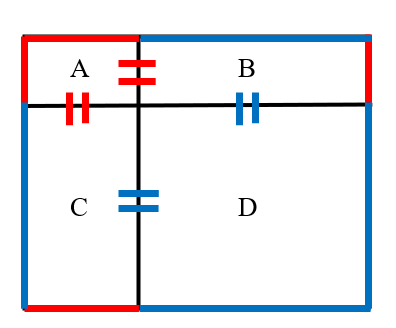
Final answer: .
In the diagram, all angles are right angles and the lengths of the sides are given in centimeters.Note the diagram is not drawn to scale. What is the length in , in centimeters?

- A.
- B.
- C.
- D.
- E.
Using the translation method, we find that:
Solving for :
Thus, the length of is .
In the backyard, there is a rectangular flower bed with a square vegetable garden inside it. Emily wants to put a fence around its outer edge. What is the perimeter of the flower bed in feet?

- A.
- B.
- C.
- D.
- E.
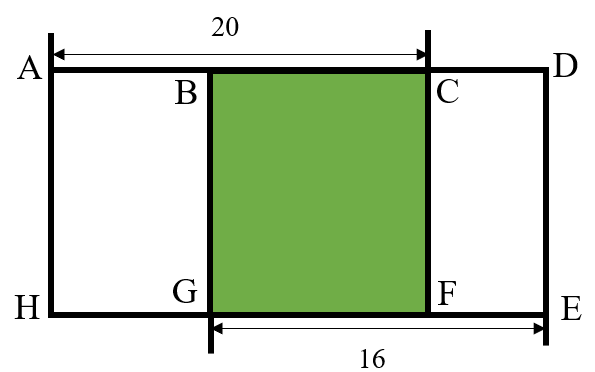
The perimeter of the rectangle = .
Since , , and , , , we can calculate the perimeter of the rectangle as follows:
The perimeter of the rectangle
So the perimeter of the rectangular flower bed is feet.
A figure is formed by arranging small pieces of paper of the same size as shown in the diagram. Given that the length of each small piece of paper is centimeters, what is the total perimeter of the shaded parts in the figure?

- A.
- B.
- C.
- D.
- E.
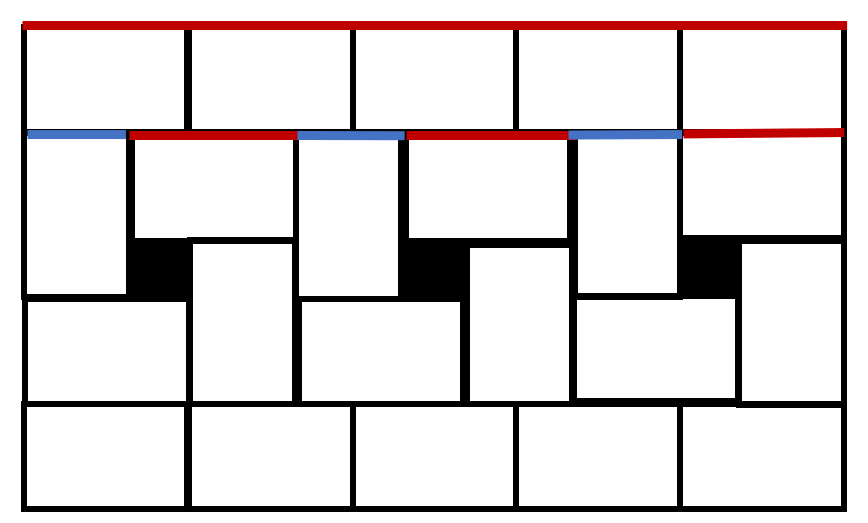
As shown in the diagram, we can observe that lengths lengths widths.
Therefore, lengths widths.
Given that the length is , the width can be calculated as follows: .
The perimeter of one shaded part is .
Thus, the total perimeter of the shaded parts is: .
There is a rectangular flower bed. In the middle of the flower bed, there is a pedestrian path with a width of meters. The flower bed is meters long and meters wide. What is the area of the pedestrian path in square meters?
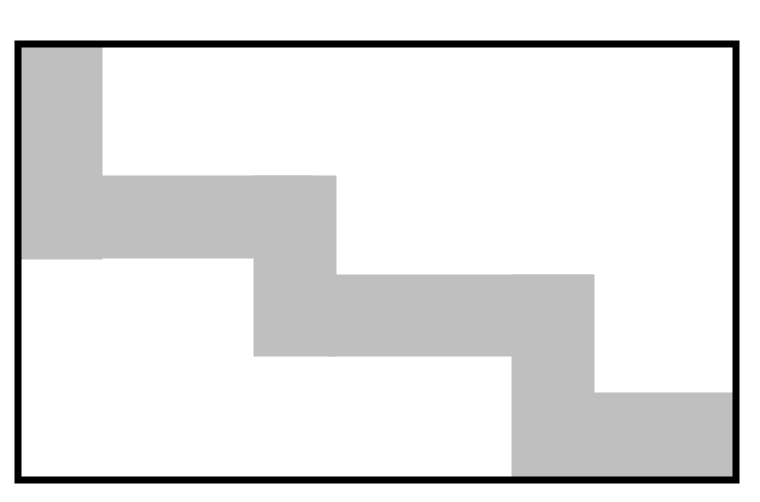
- A.
- B.
- C.
- D.
- E.
Through observation, we can translate the path to the position as shown in the following figure.

Therefore, the area of the pedestrian path is calculated as:
As shown in the figure below, the side length of square is centimeters, and the rectangle has a length of centimeters and a width of centimeters. What is the difference between the areas of the two shaded parts?
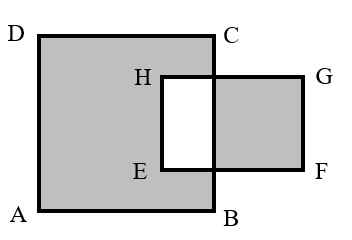
- A.
- B.
- C.
- D.
- E.

As shown in the figure, let the areas of the three regions be denoted as , , and respectively.
We have:
Then, the difference between the areas of the two shaded parts is:
A large square and a small square are placed side by side, with the side length of the small square being . What is the area of the shaded part?

- A.
- B.
- C.
- D.
- E.
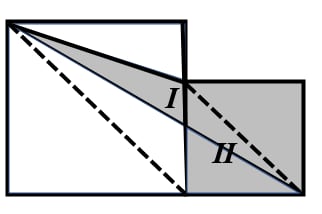
As shown in the figure, connect the diagonals of the two squares.
Since the two diagonals are parallel, we find that the area of triangle is equal to the area of triangle .
Therefore, the area of the shaded part is converted to the area of the small square, which is:
The area of a regular octagon is square centimeters. What fraction of the area of the octagon is shaded?
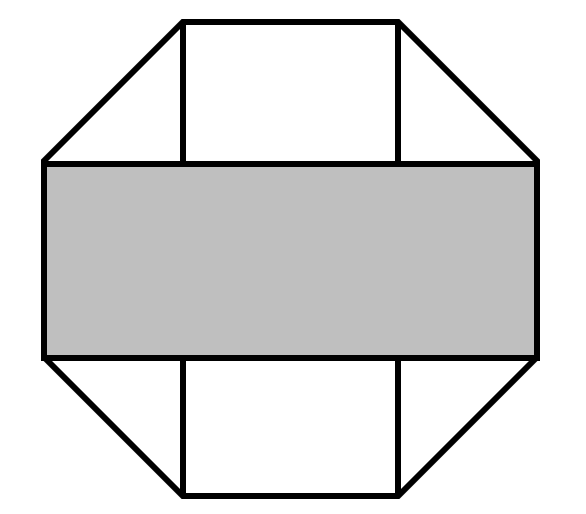
- A.
- B.
- C.
- D.
- E.

By means of division, the octagon is divided into rectangles and triangles.
The shaded part contains rectangles and triangles.
Therefore, the area of the shaded part accounts for of the total area.
In parallelogram , and are the midpoints of and respectively. Given that and , what is the area of the parallelogram?

- A.
- B.
- C.
- D.
- E.
Draw through point parallel to , and draw through point parallel to .
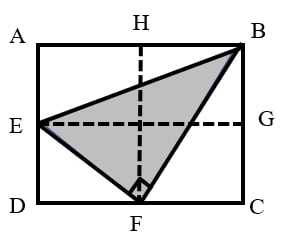
We observe that:
The area of is of the area of the parallelogram.
The area of is of the area of the parallelogram.
The area of is of the area of the parallelogram.
Therefore, the area of is of the area of the parallelogram.
The area of is calculated as: .
Let the area of the parallelogram be .
Then: .
Solving for : .
Thus, the area of the parallelogram is .
As shown in the figure, in triangle , , , point is the midpoint of side , and bisects the perimeter of triangle . What is the length of ?

- A.
- B.
- C.
- D.
- E.
Since bisects the perimeter of triangle , the perimeter of triangle is equal to the perimeter of triangle .
That is: .
Simplifying, we get: .
Since is the midpoint of , .
Substituting this into the equation above, we have:
Given , it follows that .
In the right triangle with , by the Pythagorean theorem: .
Since is the midpoint of , the length of is: .
In a triangle, the largest angle is times the smallest angle, and the other angle is times the smallest angle. What is the degree measure of the largest angle?
- A.
- B.
- C.
- D.
- E.
Let the three angles of the triangle be , , and , where .
According to the problem, we know that and .
Thus, the ratio of the angles is .
Since the sum of the interior angles of a triangle is , the measure of the largest angle is: .
Two equilateral triangles and lie on the same horizontal plane, with areas and respectively. What is the area of triangle ?
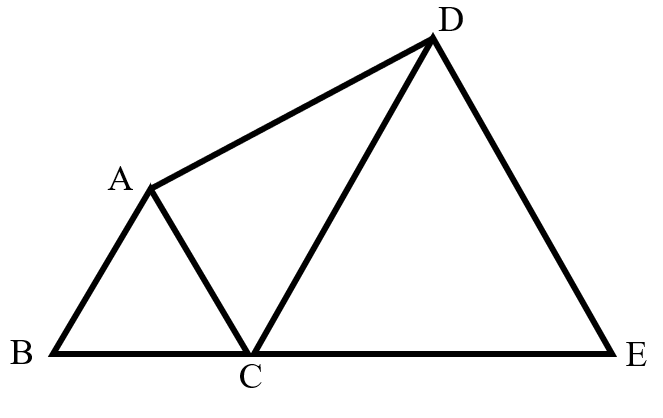
- A.
- B.
- C.
- D.
- E.
Since triangles and are equilateral, and .
Given that the area of a triangle is , we have:
: = :
: = :
Since and , it follows that: .
Let the area of be .
Then: .
Solving for : .
Thus, the area of is .
The perimeter of a triangle is , and its shortest side is . If all three sides of the triangle are integers, what is the maximum possible length of the longest side in centimeters?
- A.
- B.
- C.
- D.
- E.
Assume the three sides of the triangle, arranged in ascending order, are , , and .
According to the triangle inequality theorem, the sum of any two sides of a triangle must be greater than the third side, so: .
Since the perimeter of the triangle is cm, we have: , which simplifies to: .
Substituting into the inequality , we get: , , , .
Since is an integer, the maximum possible value of is .
Thus, the longest side can be at most centimeters.
What is the largest whole number smaller than the perimeter of any triangle with a side of length and a side of length ?
- A.
- B.
- C.
- D.
- E.
From the Triangle Inequality Theorem, we know that for the third side of the triangle, the following must hold: and .
Let be the perimeter of the triangle, so .
Adding to all parts of the inequality for , we get:
Thus, the largest whole number smaller than the perimeter of any such triangle is .
As shown in the figure below, three cubes with edge lengths of , , and are attached closely together. What is the surface area of the resulting three-dimensional figure in square centimeters?
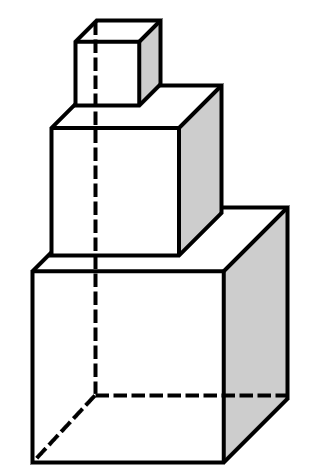
- A.
- B.
- C.
- D.
- E.
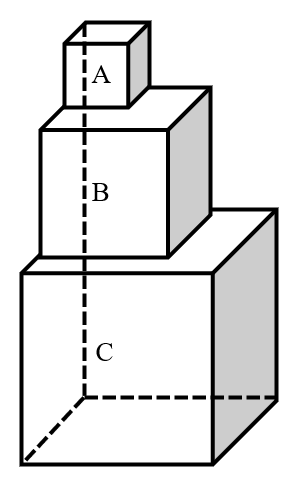
Through observation, we find that when the three cubes are attached closely together, some surfaces are covered:
the bottom surface of cube , part of the top and bottom surfaces of cube , and part of the top surface of cube .
The total surface area is calculated as follows: .
The following is a plane development diagram of a cube. If the values on the two opposite faces of the cube are equal, what is the value of ?
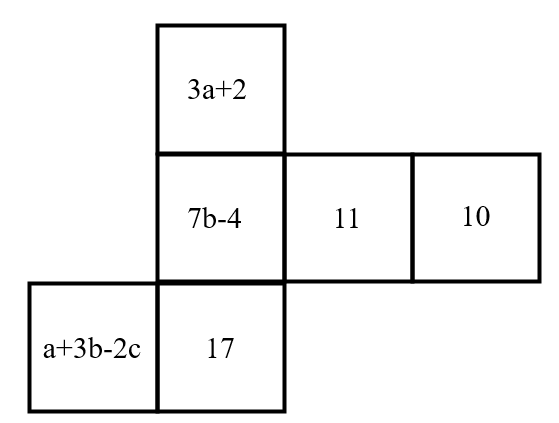
- A.
- B.
- C.
- D.
- E.
Through observation, we find three pairs of opposite faces as shown in the figure.
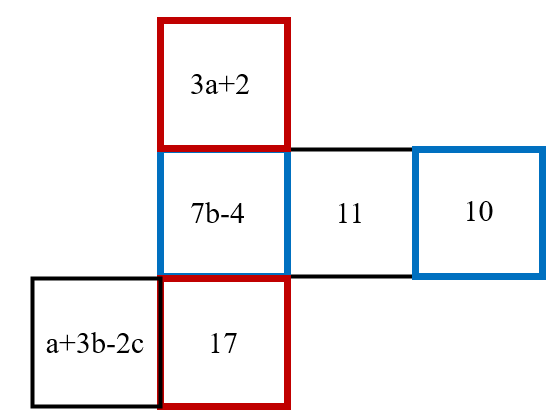
Since the values on opposite faces are equal, we have the following equations:
Solving these equations: -
From , we get , so .
From , we get , so . -
Substituting and into , we have , which simplifies to , so .
Finally, we calculate :
Mike folded a piece of paper into a cube-shaped box, put a gift inside, and mixed it with the boxes below. Which box contains the gift?
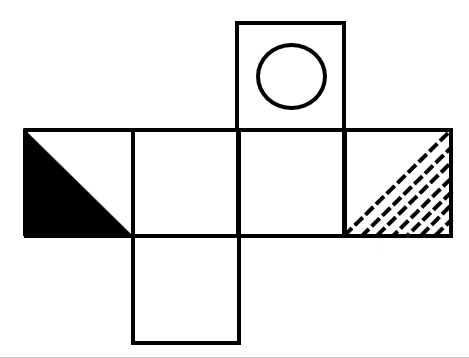
- A.
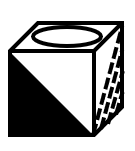
- B.

- C.
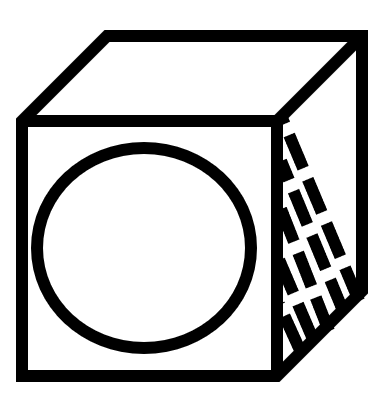
- D.
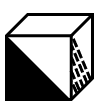
- E.

As shown in the figure, first identify the corresponding faces in the cube.
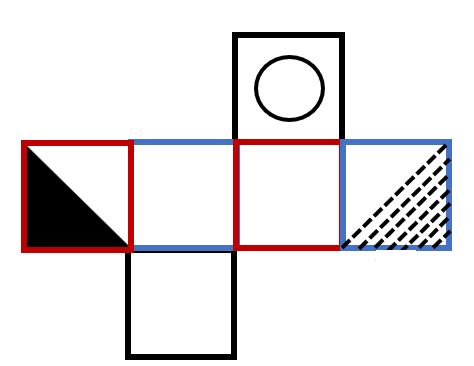
Based on the characteristics and positions of various symbols in the unfolded diagram, it is found that the black triangle and the slanted-line triangle should be adjacent faces with one side overlapping.
Therefore, the correct choice is .
There is a cylindrical part with a height of centimeters and a base diameter of centimeters. One end of the part has a straight cylindrical hole, as shown in the figure: the diameter of the circular hole is centimeters, and the depth of the hole is centimeters. If the parts of this component that are exposed to air are to be painted with anti-rust paint, what is the total area to be painted in square centimeters?(For convenience, use .)
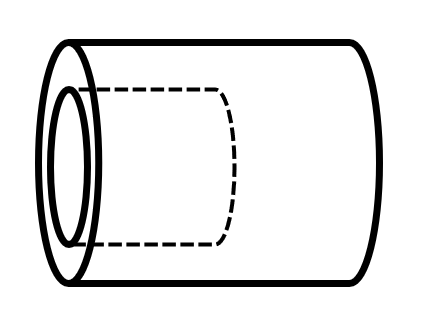
- A.
- B.
- C.
- D.
- E.
The total area to be painted includes the outer surface area of the cylinder, the inner surface area of the hole, and the area of the two circular bases (adjusted for the hole).
The calculation is as follows:
The total area to be painted is square centimeters.
There is a cube wooden block with an edge length of . There are penetrating holes (shown as black parts in the figure) when viewed from the front and the right side. What is the volume of this three-dimensional figure in cubic centimeters?
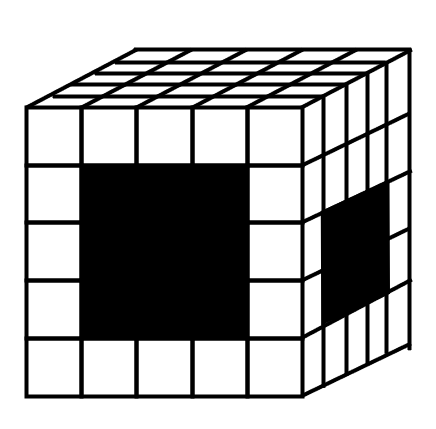
- A.
- B.
- C.
- D.
- E.
We can calculate the volume by dividing the cube into five layers from top to bottom:

The first and fifth layers have no holes, and the volume of each layer is cubic centimeters.
The volume of the second layer is cubic centimeters.
The volume of the third layer is cubic centimeters.
The volume of the fourth layer is cubic centimeters.
Adding them up, the total volume is: cubic centimeters.
A part of a circular glass mirror is damaged. To obtain a mirror of the same size, a worker uses a right-angle ruler for measurement as shown in the figure, and finds that and . What is the diameter of the circular mirror in centimeters?

- A.
- B.
- C.
- D.
- E.
It is known that the circumferential angle subtended by a diameter is a right angle.
Therefore, connecting forms a right triangle with , and is the diameter of the circular mirror.
By the Pythagorean theorem in :
Thus, the diameter of the circular mirror is centimeters.
As shown in the figure, is a rectangle with length , width , and diagonal length . It is rotated clockwise around point . Find the area swept by side .(Take )

- A.
- B.
- C.
- D.
- E.
The area swept by side is the area of the shaded part in the figure.
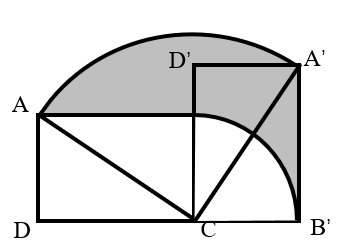
The area swept by = () -().
Since the area of is equal to the area of , this simplifies to: .
Calculating the areas of the sectors :
Answer: The areas swept by sides is square units.
In the figure on the right, two sectors with central angles of are placed on top of a large circle, and a small circle is placed on top of the two sectors. All four shapes share the same center. If the ratio of the radii of the small circle, the large circle, and the sectors is , what percentage of the total area is occupied by the shaded region?
- A.
- B.
- C.
- D.
- E.
Let the radii of the large circle, the small circle, and the sectors be , , and respectively.
The total area of the logo is
The area of the shaded region is
Therefore, the shaded region occupies
of the total area of the logo.
Some squares are inscribed in a set of concentric circles, as shown in the figure. Given that the radius of the smallest circle is , what is the area of the shaded part in square centimeters? (Take )
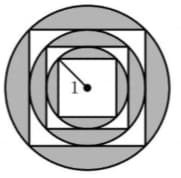
- A.
- B.
- C.
- D.
- E.
We calculate the area of the shaded part by dividing it into three parts:
the inner circle, the middle circle, and the outer circle.
the inner shaded area = the area of the inner circle - the area of the inner square:
The diameter of the inner circle is the side length of the middle square, which is . The diagonal of the middle square is the diameter of the middle circle.
Thus, the area of the middle shaded part is:
.
The area of the outer square is equal to the square of the diameter of the middle circle, which is . The square of the diagonal of the outer square is twice its area, so it is cm², which equals the square of the diameter of the outer circle.
Thus, the area of the outer shaded part is:
Adding up the three parts, the total area of the shaded part is:
Substituting :
Answer: The area of the shaded part is .
With each of the three vertices of an equilateral triangle with a side length of centimeters as the center, arcs are drawn with a radius of centimeters. What is the perimeter of the shaded figure in centimeters? (Take )
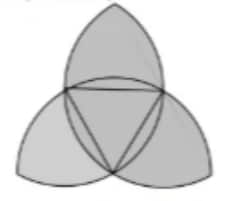
- A.
- B.
- C.
- D.
- E.
Each arc is of the circumference of a circle because the central angle of each arc is .
Therefore, the perimeter of the shaded figure is composed of such arcs.
The length of one arc is:
The total perimeter of the shaded figure is:
Thus, the perimeter of the shaded figure is centimeters.
Andy and Emily start from the same location. Andy walks meters west, and Emily walks meters south. Then Andy walks meters north, and Emily walks meters east. How far apart are they at this point?
- A.
- B.
- C.
- D.
- E.
We draw a diagram.

The distance between them is:
The figure below consists of three right triangles. What is the value of ?
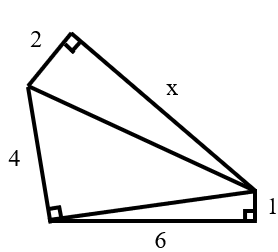
- A.
- B.
- C.
- D.
- E.
Since all three triangles in the figure are right triangles, we apply the Pythagorean theorem:
What is the length of ?
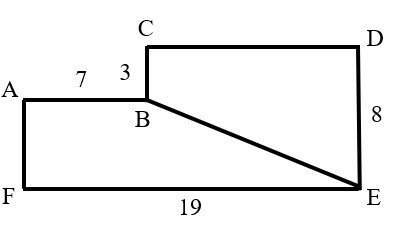
- A.
- B.
- C.
- D.
- E.
Draw a perpendicular line from point to , with the intersection point being .
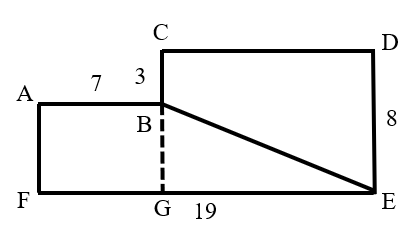
Then: , .
Since is a right triangle, by the Pythagorean theorem:
.
As shown in the figure, there is a lawn. It is known that , , , , and . Find the area of this lawn.
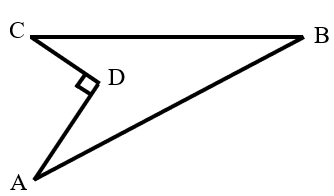
- A.
- B.
- C.
- D.
- E.
Connect .
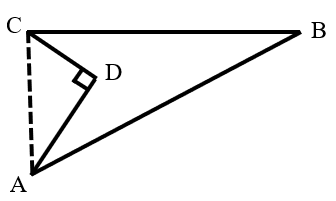
Since , in the right triangle : .
Given and , we find that , so is also a right triangle.
The area of the lawn is:
As shown in the figure, there are two monkeys at point , which is meters high on a tree. One monkey climbs down the tree to reach point (a pond meters away from the tree), and the other climbs to the top of the tree and then jumps directly to . The distance of the jump is calculated as a straight line. If the distances traveled by the two monkeys are equal, what is the height of the tree in meters?
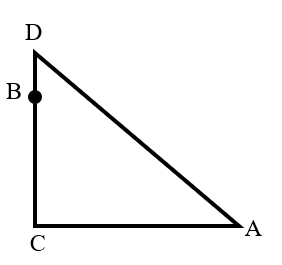
- A.
- B.
- C.
- D.
- E.
Let .
In the right triangle : .
Since the distances traveled by the two monkeys are equal:
Solving this equation gives .
Thus, the height of the tree is meters.
- 1
- 2
- 3
- 4
- 5
- 6
- 7
- 8
- 9
- 10
- 11
- 12
- 13
- 14
- 15
- 16
- 17
- 18
- 19
- 20
- 21
- 22
- 23
- 24
- 25
- 26
- 27
- 28
- 29
- 30
